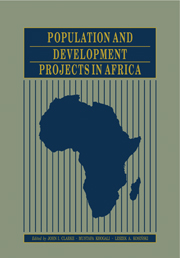Book contents
- Frontmatter
- Contents
- List of Tables
- List of Figures
- List of Contributors
- Preface
- 1 The demographic background to development in Africa
- 2 Development projects and their demographic impact
- 3 Conceptualization of the impacts of rural development projects upon population redistribution
- 4 Capitalism and the population landscape
- 5 Unequal participation of migrant labour in wage employment
- 6 Africa's displaced population: dependency or self-sufficiency?
- 7 Population redistribution and agricultural settlement schemes in Ethiopia, 1958–80
- 8 Populating Uganda's dry lands
- 9 Environmental and agricultural impacts of Tanzania's villagization programme
- 10 Development and population redistribution: measuring recent population redistribution in Tanzania
- 11 Communal villages and the distribution of the rural population in the People's Republic of Mozambique
- 12 A century of development measures and population redistribution along the Upper Zambezi
- 13 Resettlement and under-development in the Black ‘Homelands’ of South Africa
- 14 Development programmes and population redistribution in Nigeria
- 15 Population, disease and rural development programmes in the Upper East Region of Ghana
- 16 Demographic intermediation between development and population redistribution in Sudan
- 17 A typology of mobility transition in developing societies, with application to North and Central Sudan
- 18 Rural population and water supplies in the Sudan
- 19 The impact of the Kenana Project on population redistribution
- 20 Migrant labour in the New Halfa Scheme
- 21 The Gash Delta: labour organization in pastoral economy versus labour requirements in agricultural production
- 22 The impact of development projects on population redistribution to Gedaref Town in Eastern Sudan
- 23 The growth of Juba in Southern Sudan
- Index
10 - Development and population redistribution: measuring recent population redistribution in Tanzania
Published online by Cambridge University Press: 05 November 2011
- Frontmatter
- Contents
- List of Tables
- List of Figures
- List of Contributors
- Preface
- 1 The demographic background to development in Africa
- 2 Development projects and their demographic impact
- 3 Conceptualization of the impacts of rural development projects upon population redistribution
- 4 Capitalism and the population landscape
- 5 Unequal participation of migrant labour in wage employment
- 6 Africa's displaced population: dependency or self-sufficiency?
- 7 Population redistribution and agricultural settlement schemes in Ethiopia, 1958–80
- 8 Populating Uganda's dry lands
- 9 Environmental and agricultural impacts of Tanzania's villagization programme
- 10 Development and population redistribution: measuring recent population redistribution in Tanzania
- 11 Communal villages and the distribution of the rural population in the People's Republic of Mozambique
- 12 A century of development measures and population redistribution along the Upper Zambezi
- 13 Resettlement and under-development in the Black ‘Homelands’ of South Africa
- 14 Development programmes and population redistribution in Nigeria
- 15 Population, disease and rural development programmes in the Upper East Region of Ghana
- 16 Demographic intermediation between development and population redistribution in Sudan
- 17 A typology of mobility transition in developing societies, with application to North and Central Sudan
- 18 Rural population and water supplies in the Sudan
- 19 The impact of the Kenana Project on population redistribution
- 20 Migrant labour in the New Halfa Scheme
- 21 The Gash Delta: labour organization in pastoral economy versus labour requirements in agricultural production
- 22 The impact of development projects on population redistribution to Gedaref Town in Eastern Sudan
- 23 The growth of Juba in Southern Sudan
- Index
Summary
Types of development: the scale of their impact on population redistribution and sources of data
This paper will use the notion of development projects in two ways. The narrow, and more common, usage refers to readily identifiable schemes with a starting date, a specified location and extent, and – commonly – a pre-determined population size (or set of sizes), at least for the early years of the scheme (Lele, 1975: 8–11). In Tanzania, examples of the range of development projects of this sort include: estate production of tea, coffee, sisal and wattle; irrigation projects to extend rice farming on formerly uncultivated lands; the designation of forest reserves and game parks, such as that controlled by the Conservation Authority in Ngorongoro and in a host of less well-known but sometimes very extensive game reserves (the Selous and Ruaha Parks for instance); the planned expansion of existing towns, as in the case of Dodoma following its choice as the new capital; the construction of hydroelectric and water control schemes in the Pangani and Rufiji river basins; the mining of diamonds and gold, each with its peculiar organization and effects on population redistribution; and the building of cement, textile and other factories in towns or in the countryside. All of these were associated with the movement of people (Thomas, 1971; Egero, 1974). However, the numbers involved were relatively small – often only a few hundreds, occasionally up to tens of thousands, seldom more.
Information
- Type
- Chapter
- Information
- Population and Development Projects in Africa , pp. 141 - 152Publisher: Cambridge University PressPrint publication year: 1985
Accessibility standard: Unknown
- 3
- Cited by
